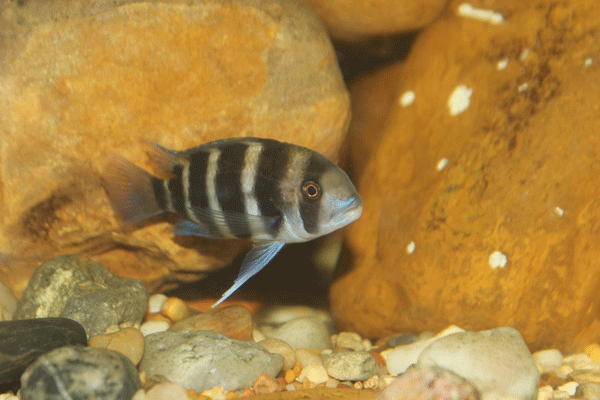Photo: Juvenile Cyphotilapia frontosa
This week we processed once again our “breeding colony” of Cyphotilapia frontosa. I put breeding colony in quotes since up until now they hadn’t bred at all.
This is a large cichlid from Africa’s Lake Tanganyika. Mature males grow to over a foot in length. Both sexes sport about six (this varies from five to seven) vertical black bars on a whitish, sometimes bluish body. Distal fin tips tend to be whitish. Both sexes also have nuchal (head) humps, but the males’ are more pronounced. They are striking due to size and deportment.
I had never in all my years of fishkeeping bred this species. Of course, until three years ago I’d never tried. I’d had some of these fish in sales tanks when (long, long ago) I owned retail fish stores, but never had breeding adults. Then four years ago Roger Degregori of the Fish Gallery offered me some juveniles to grow out for his stores. I decided to hold some back to form a breeding colony. Roger was eager for me to do this since he wanted a reliable source. Now, I’d heard they were difficult to breed, but I’ve raised many difficult species, often finding them not that difficult. So, after growing out the fish I confidently set aside three males and six females and shipped the rest to Fish Gallery stores in Houston, Dallas, and Austin.
About a year after getting the fish, when they were probably a year and half old, I set up the breeders in a 300 gallon vat. Three years of breeding cycle after breeding cycle (each about three to four months) they produced zilch, nada, nothing. Finally, last October, disgusted with them, I placed them in a 300 gallon vat along with some young peacock cichlids I’d bought on impulse in California while there speaking at two clubs. I added some large Synodontis eupterus, the featherfin catfish that I was growing up to attempt breeding. I topped the vat off with feeder guppies (these fish thrive with cichlids if there is any cover at all) and red cherry shrimp. Also, a fair population of scuds was already living in the vat. I pretty much forgot about them.
This week I processed that vat, not for the C. frontosa, but to segregate out the S. eupterus for possible breeding and to set up a breeding colony of the peacocks (some nice albino dragon bloods). To my surprise there were three three-inch long C. frontosa juveniles! Judging from the size of the juveniles, they were four to five months old. This species grows much slower than our peacock cichlids, which at that age would be four to five long. In addition to the three juveniles, two of the females were carrying eggs. This species is a maternal mouth brooder.
I had a spare 300 gallon vat and my now really “breeding colony” was transferred into it. I stocked their new home with lots of cover (4” black drain pipe fastened to 2” PVC pipe as ballast to hold the drain pipe down and netting cages for any fry to hide in). I also added feeder guppies, red cherry shrimp and scuds since those species were in their vat when they successfully bred. I plan to feed them litter worms a couple of times a week also and continue feeding our standard high protein foods. Since the adults are supposed to be predatory on other fishes I’ll probably put some sailfin mollies in as well to provide forage for the adults.
With luck and perseverance (Susie, my wife, says “stubbornness”) I hope to begin producing significant numbers of this species. Roger will be pleased.


Leave a Reply